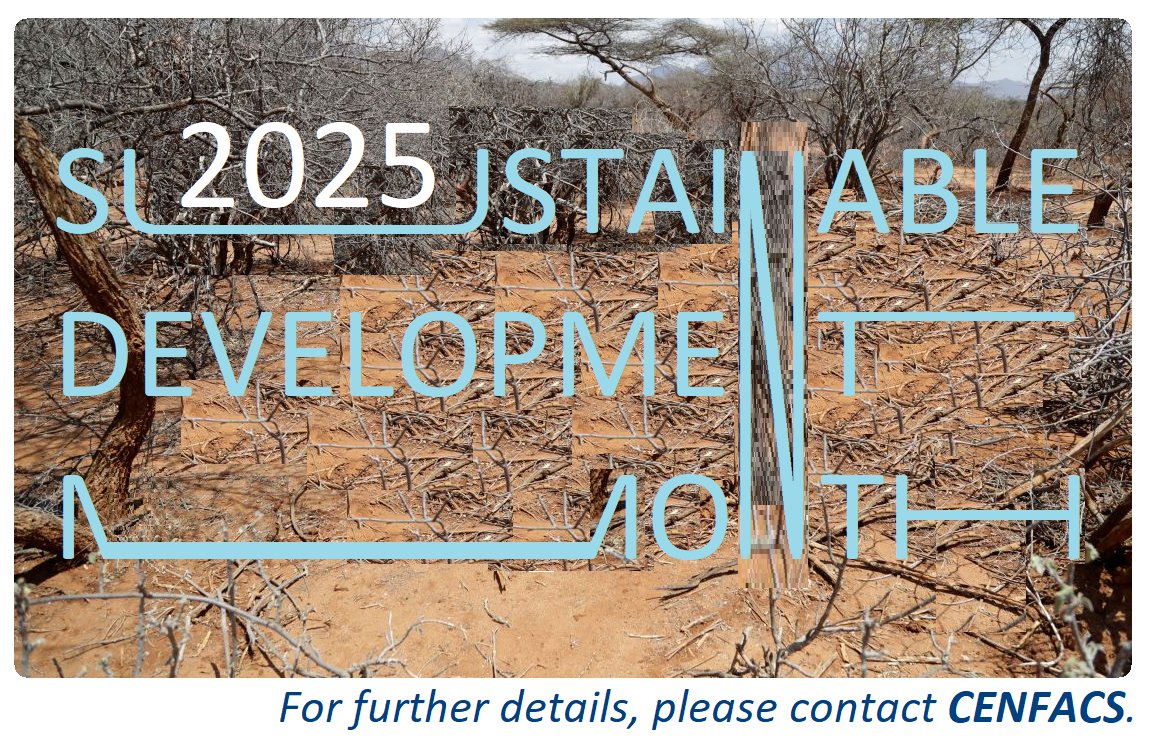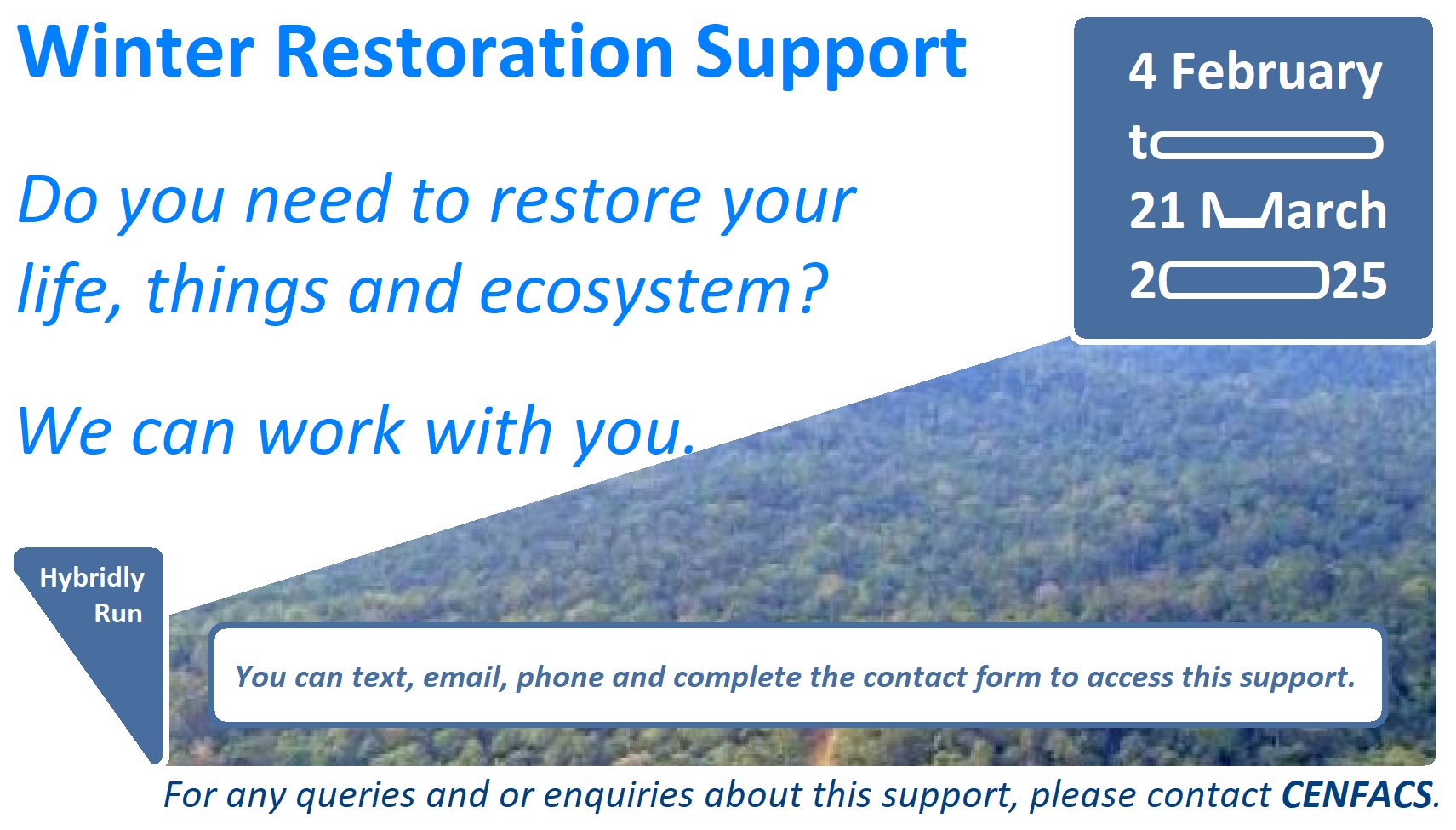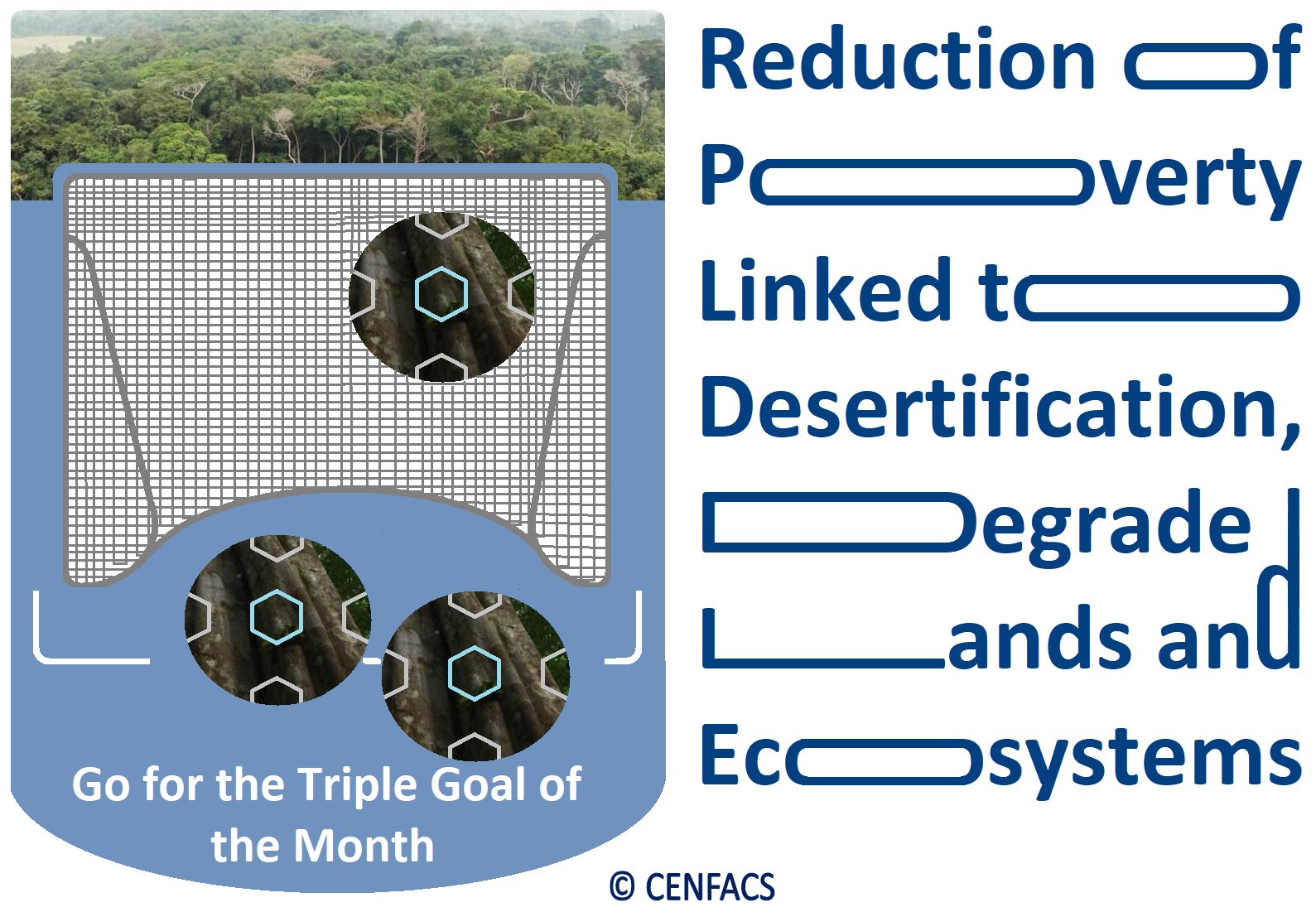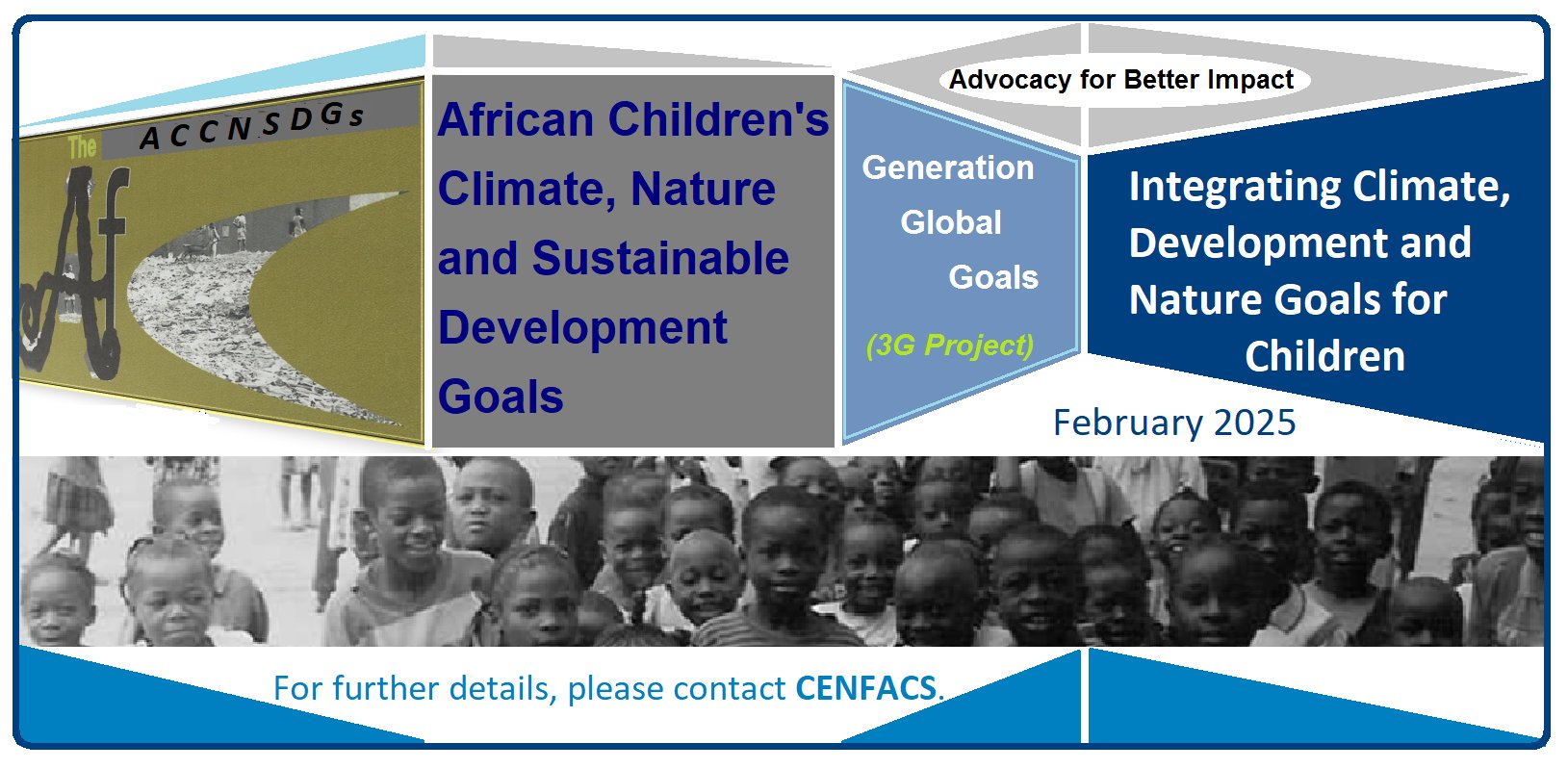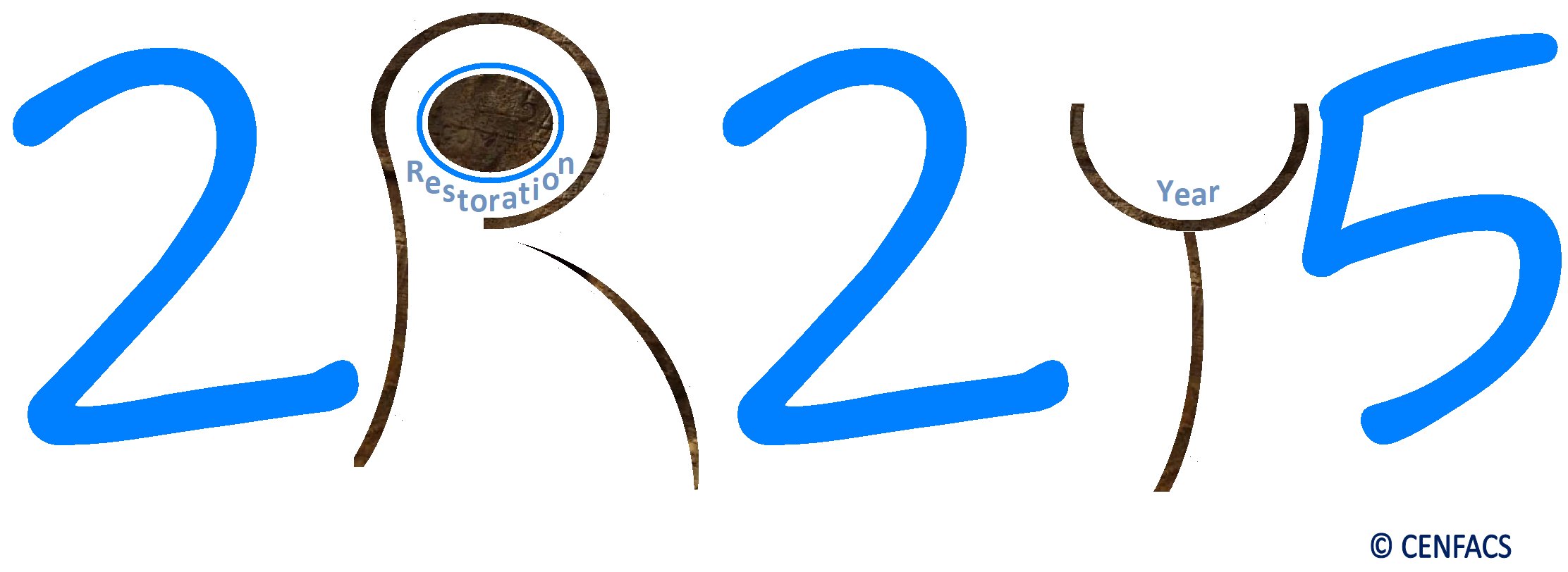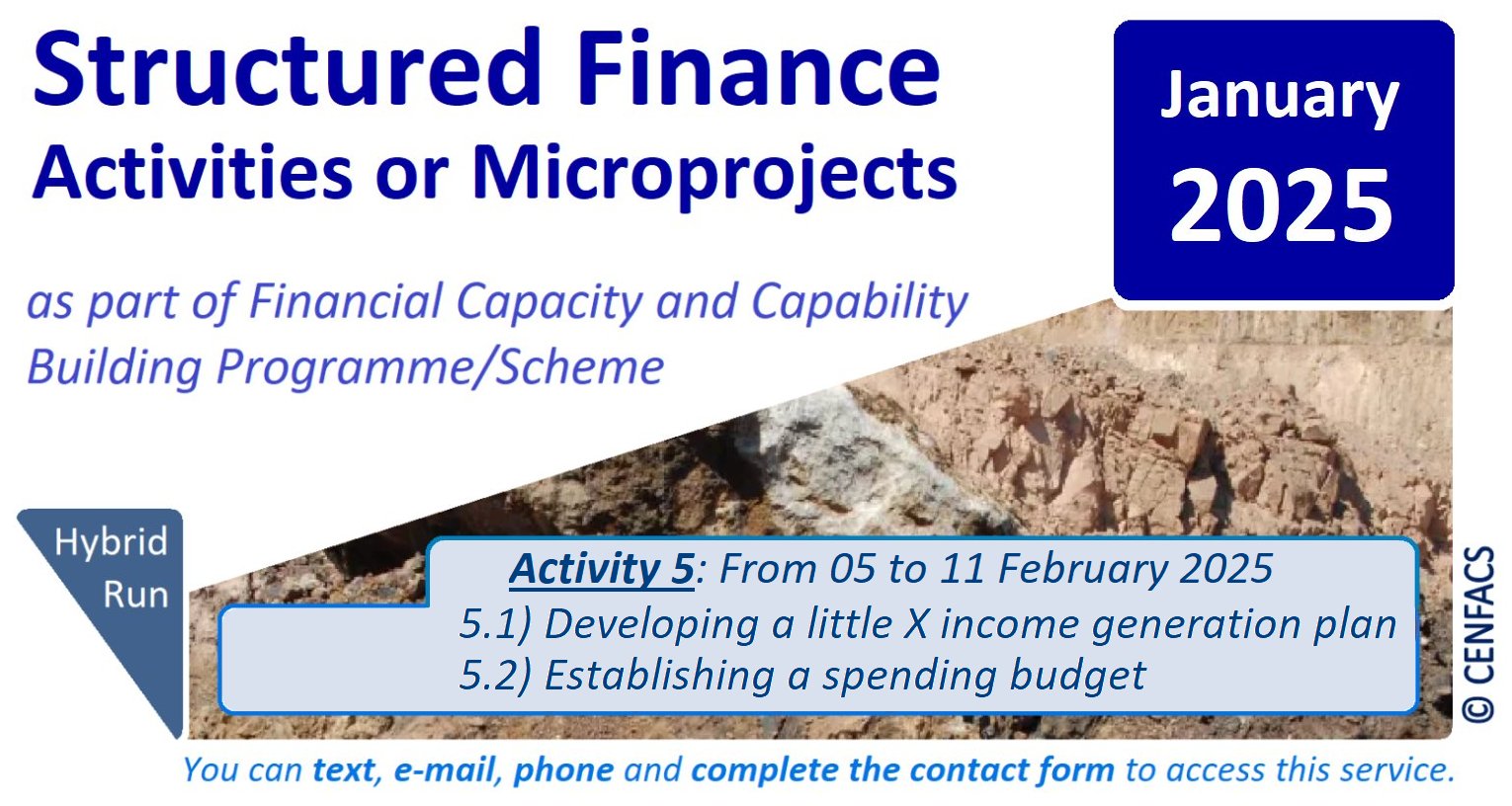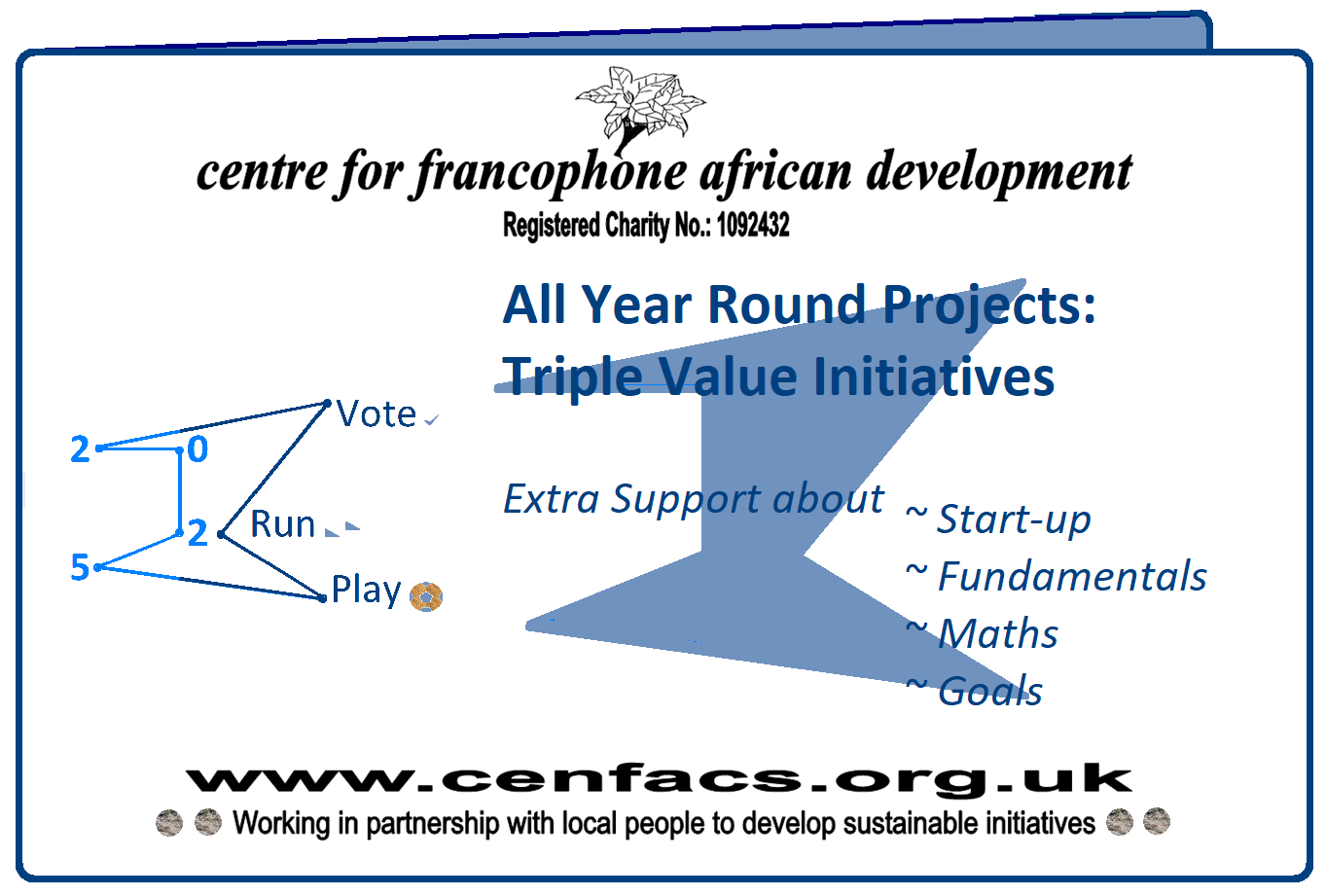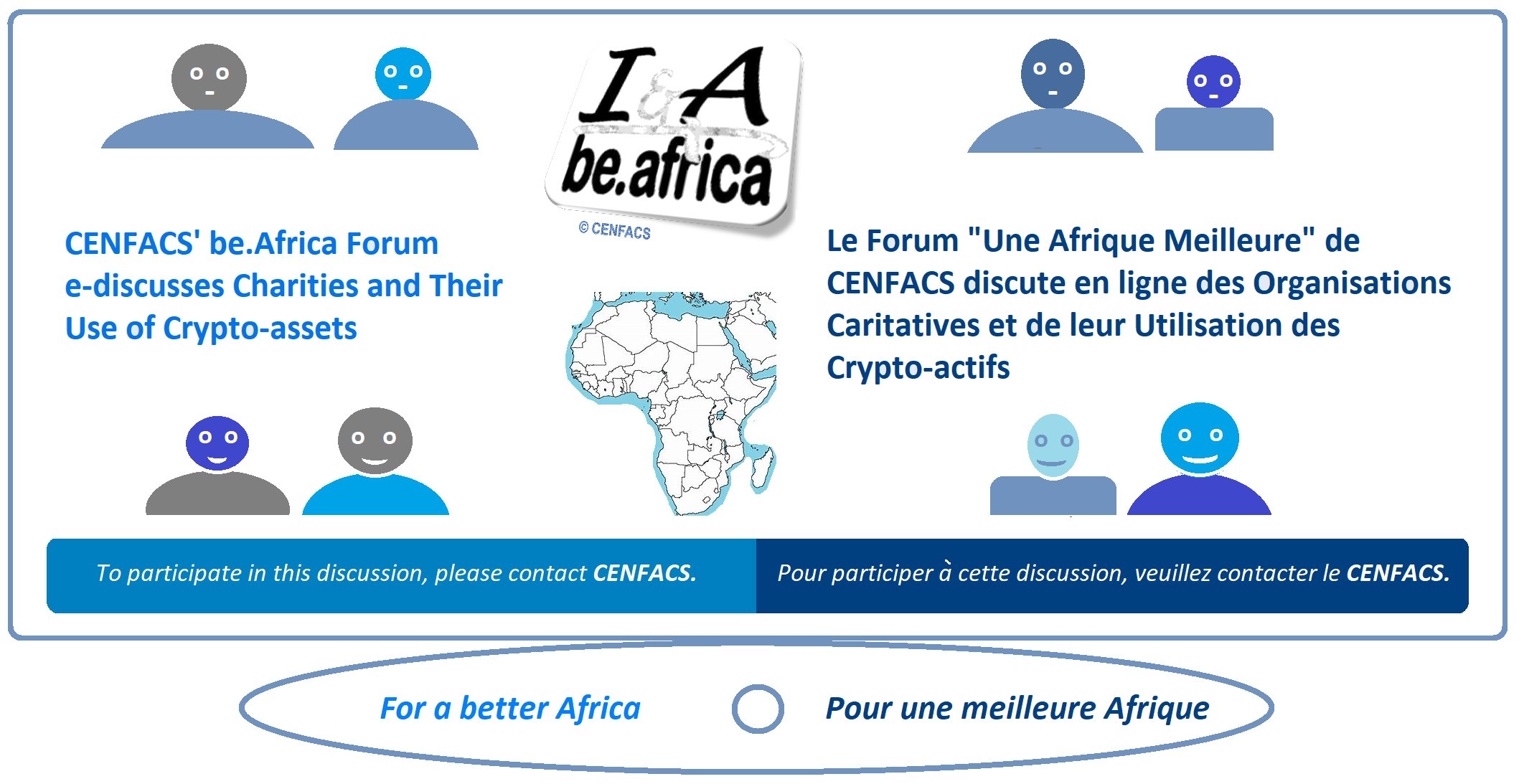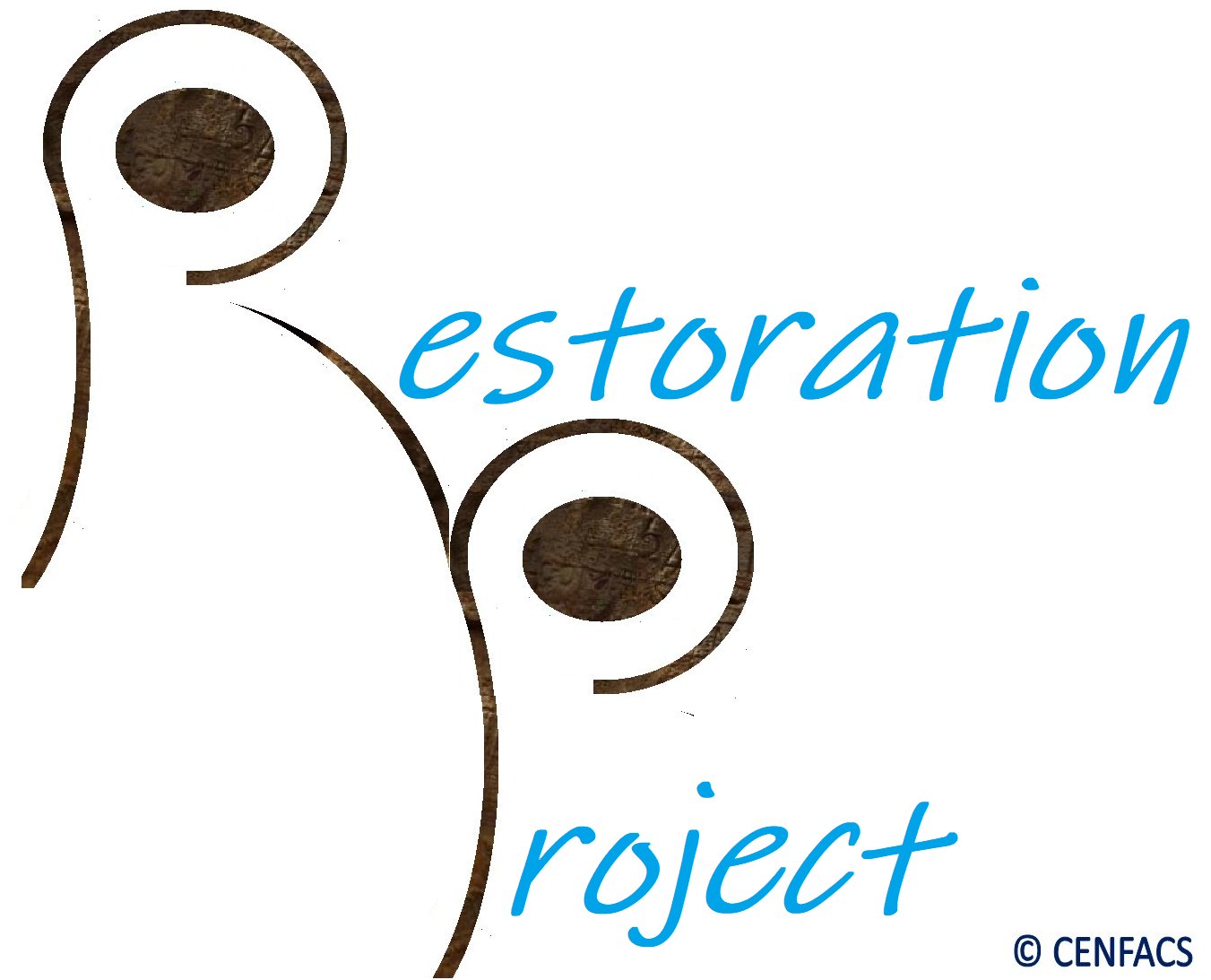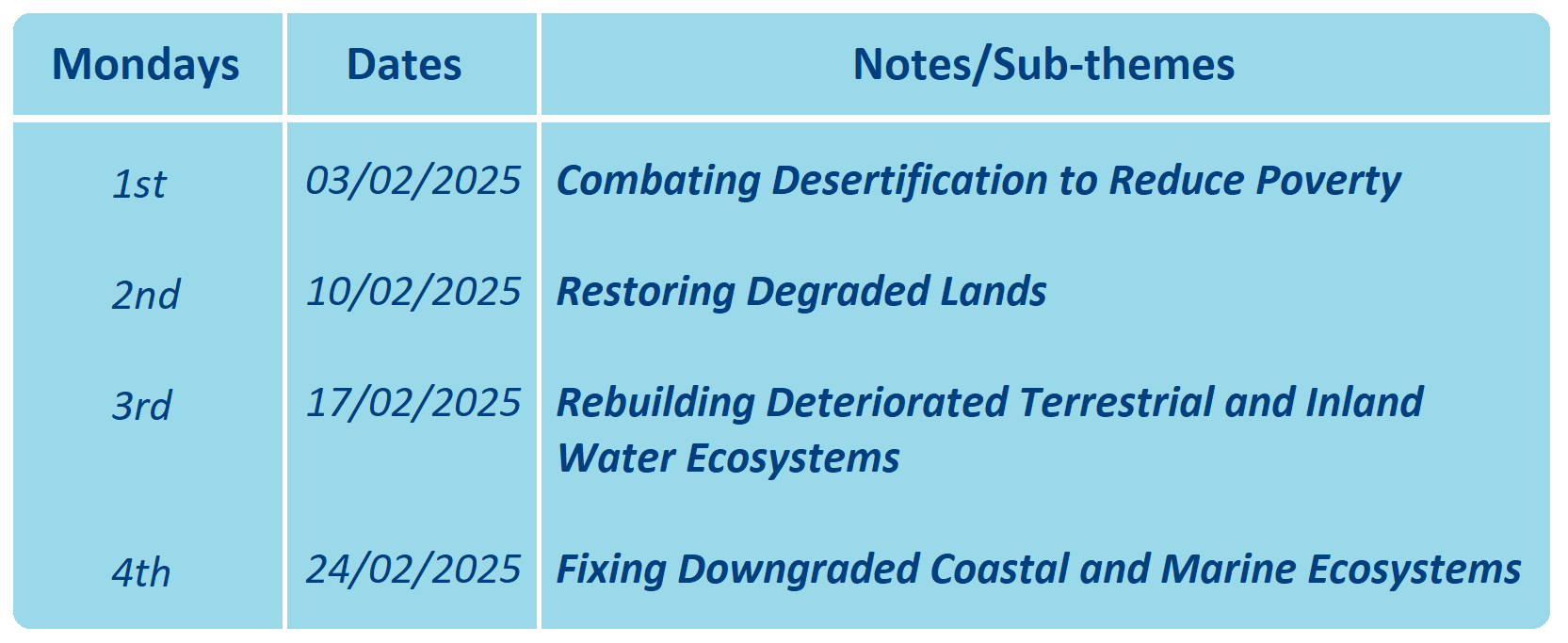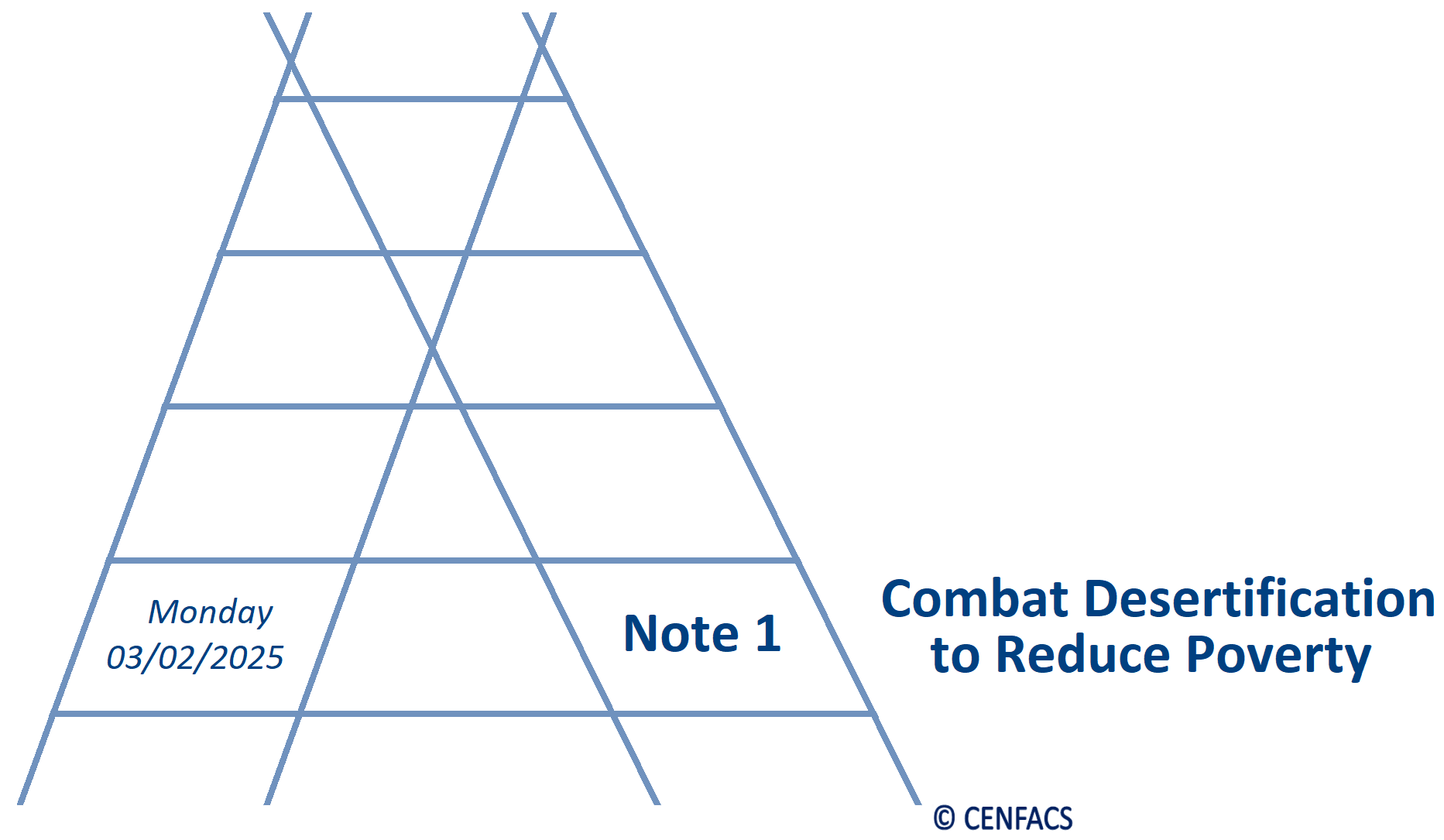Welcome to CENFACS’ Online Diary!
05 February 2025
Post No. 390
The Week’s Contents
• 2025 Sustainable Development Month with Fighting Desertification, Restoring Degraded Lands and Ecosystems While Reducing Poverty
• Go for the Triple Goal of the Month: Reduction of Poverty Linked to Desertification, Degraded Lands and Ecosystems
• African Children’s Climate, Nature and Sustainable Development Goals (Generation Global Goals Project) – In Focus: Integrating Climate, Development and Nature Goals for Children
… And much more!
Key Messages
• 2025 Sustainable Development Month with Fighting Desertification, the Restoration of Degraded Lands and Ecosystems While Reducing Poverty
February is the month of Sustainable Development, according to CENFACS development calendar or planner. It is the month during which we revisit our works relating to sustainable development. In particular, we try to look at again the United Nations (1) Seventeen Sustainable Development Goals (SDGs) and their related 169 targets. We normally select one of the topics within the set of SGDs and targets; and try to work on it. For this February 2025, we have selected Goal 15 and Target 3 of this goal. What are Goal 15 and Target 3 of the United Nations Sustainable Development Goals (UNSDGs)?
• • Goal 15 and Target 3 of UNSDGs as Working Theme for the Month of Sustainability
Goal 15 is to End Desertification and Restore Degraded Land.
Target 3 of Goal 15 is By 2030, combat desertification, restore degraded land and soils, including land affected by desertification, drought and floods, and strive to achieve a land degradation-neutral world.
Our work on the above-named Goal 15 and Target 3 is to help end or reduce poverty linked to the Target 3 of this Goal 15. In particular, we would like to work with our project beneficiaries and our Africa-based Sister Organisations to Reduce Poverty Linked to Desertification and Degraded Land and Soils.
Additionally, we shall concentrate on the Kunming-Montreal Global Biodiversity Framework (KMGBF) (2), which has 23 action-oriented global targets for urgent action over the decade to 2030. Particularly, we shall work on Target 2 of this framework.
• • Target 2 of KMGBF as Part of the Working Theme for the Month of Sustainability
The Target 2 of KMGBF is to Ensure that by 2030 at least 20 per cent of areas of degraded terrestrial, inland water, and coastal and marine ecosystems are under effective restoration, in order to enhance biodiversity and ecosystem functions and services, ecological integrity and connectivity.
Our work on Target 2 is to work with our project beneficiaries and Africa-based Sister Organisations to Reduce Poverty Linked to Degraded Ecosystems.
To make our Month of Sustainability, we are going to engage our community members and Africa-based Sister Organisations through Target 3 of the UNSDG 15 and Target 2 of the KMGBF, while keeping the spirit of these targets as they were originally set up. Additionally, we are looking at how the contents of these targets can be related to poor people, particularly poor and vulnerable households that make up CENFACS‘ noble and beautiful cause of poverty reduction.
• • Engaging our Members and Africa-based Sister Organisations via Combat against Desertification, Restoration of Degraded Lands and Ecosystems While Reducing Poverty
We are engaging or reminding the members of our community and Africa-based Sister Organisations to be aware of and act on the messages contained in the Target 3 of UNSDG 15 and Target 2 of KMGBF, while supporting them on how they can be mindful in applying them in real life. In particular, we are and will be working with the community in restoration micro-projects or activities for those of our members who would like to restore their lives or things or ecosystems. We are and will be working with Africa-based Sister Organisations having sustainable restoration projects and that would like us to get involved.
To enable us to approach the theme of Fighting Desertification, Restoring Degraded Lands and Ecosystems While Reducing Poverty; we have organised an action plan (please refer to the below given Schedule of Notes).
For further information about this theme, please read under the Main Development section of this post.
• Go for the Triple Goal of the Month: Reduction of Poverty Linked to Desertification, Degraded Lands and Ecosystems
Our goal for February 2025 is triple. It is about reducing poverty linked to desertification, poverty relating to degraded land and poverty caused by downgraded ecosystems. These are the three forms of poverty we are trying to help reduce this February 2025. Let us explain them.
• • Three Forms of Poverty to Help Reduce This February 2025
• • • Reducing poverty linked to degraded land
It is about
σ avoiding overgrazing or excessive logging or deforestation which reduce poor communities’ ability to produce food and income
σ improving access to essential resources (such as food and water)
σ eliminating or decreasing the impacts of land degradation on poor people
σ enhancing land yields to bring food security
σ ameliorating access to clean and safe water to decrease exposure to water-born diseases and illnesses
σ reducing the causes of conflict over minerals (like in the case of the eastern part of Democratic Republic of Congo where conflict minerals are causing war and suffering for the ordinary people)
etc.
• • • Reducing poverty related to desertification
The reduction of desertification caused by degraded desertification can help reduce poverty for those poor living on farm land.
Reducing poverty for these poor, in relation to desertification, is about
σ improving land productivity to facilitate food growth and poverty reduction
σ increasing food security
σ ameliorating livelihoods and growth of produce from land that is not degraded
etc.
• • • • Reducing poverty caused by degraded ecosystems
Those living in poverty are very likely to be dependant on ecosystems for their food, health, water, housing, protection and spiritual needs. Because of that, if ecosystems degrade, the possibility for them to reduce poverty becomes highly difficult. Therefore, improving the health and wealth of ecosystems will lead to the reduction of poverty they are experiencing.
• • Implications for Selecting the Goal for the Month
After selecting the goal for the month, we focus our efforts and mind set on the selected goal by making sure that in our real life we apply it. We also expect our supporters to go for the goal of the month by working on the same goal and by supporting those who may be suffering from the type of poverty linked to the goal for the month we are talking about during the given month (e.g., February 2025).
For further details on the goal of the month, its selection procedure including its support and how one can go for it, please contact CENFACS.
• African Children’s Climate, Nature and Sustainable Development Goals (Generation Global Goals Project) – In Focus: Integrating Climate, Development and Nature Goals for Children
Normally, the project that carries this month of Sustainable Development is African Children’s Climate, Nature and Sustainable Development Goals (ACCNSDGs). It is also known as Generation Global Goals (3G) project.
3G project is the impact level in CENFACS’ process of advocating that global goals (like the United Nations Sustainable Development Goals or Kunming-Montreal Global Biodiversity Framework) work for children and not way around. It is indeed the testing of the gains that global goals claim to achieve and of their impact on the welfare and well-being of children. This is regardless whether these children are in spaces and times of peace or lack of peace (like conditions of wars, areas stricken by viruses or epidemics and time of natural disasters). Unsurprisingly, these gains should be materialised even in time of crisis like of the cost-of-living crisis.
• • Children Generation of Global Goals
The children generation of global goals are those two generations of children relating to two sets of global goals: Millennium Development Goals (MDGs) and Sustainable Development Goals (SDGs). The generation of Millennium Development Goals will be those children or persons born and live between 2000 and 2015, whereas the generation of Sustainable Development Goals will be referred to those born and live from 2015 until now (ideally between 2015 and 2030). The two generations are relating to the lifespan of these two sets of goals.
These generations relating to global goals have to be differentiated from the conventional definition of generations which classified them as follows: Gen Alpha (2013 – 2025), iGen/Generation Z (1995 -2012), Millennials/Generation Y (1980 – 1994), Xennials (1975 – 1985), Generation X/Baby Bust (1965 – 1979) and Baby Boomers (1946 – 1964). This is without forgetting the generation who has been impacted by the scars or legacies of the coronavirus pandemic disaster. Most of these generations born when a particular or group of global goals was or has been set.
Although these goals were set up from different historical circumstances of their time, they are not supposed to work or to be applied independently. They can be integrated to better work. This week, we are advocating to integrate them so that they can better work for children and the generations to come.
• • Integrating Climate, Development and Nature Goals for Children
This year, the focus is on integrating climate, development and nature goals in the context of ACCNSDGs project for children. But, what are those goals we are trying to integrate?
They are:
~ Climate goal, which is, according to ‘unfccc.int'(3),
“Overarching goal to hold the increase in the global average temperature to well below 2°C above pre-industrial levels and pursue efforts to limit the temperature increase to 1.5°C above pre-industrial levels”;
~ Nature goals, which are the four long-term goals of the KMGBF (op. cit.). The framework has 23 action-oriented global targets for urgent action over the decade to 2030;
~ United Nations Sustainable Development Goals, which are the United Nations Seventeen Sustainable Development Goals and their related 169 targets (op. cit.).
It is good to work with children so that they can understand them and how these goals can work together in integrative and interactive way.
For example, the World Bank Group (4) provides the following argument regarding the integration between nature and climate change:
“Investing in nature is critical not only for maintaining biodiversity and a stable climate, but also for reducing poverty and inequality, and maintaining the critical ecosystems that support livelihoods… Tackling nature loss and climate change together offers the best hope for preventing the systemic threats they pose to development, economic growth, and the wellbeing of people and the planet” (p. 1)
Children and future generations can be protected from these threats. So, explaining and applying this integration on how they can benefit children and future generations will be useful in understanding how integrated and interconnected global goals can positively (or negatively) impact them.
For those who would like to find out more on how we can integrate these goals (i.e., Climate, Nature and Sustainable Development Goals) for and with children; they can contact CENFACS.
Extra Messages
• Activity/Task 2 of the ‘R’ Project: Restore Life and Things Sustainably
• 2025 Structured Finance Activities or Micro-projects under Financial Capacity and Capability Building Programme or Scheme: Activity 5 (05 to 11/02/2025)
• Triple Value Initiatives, All Year Round Projects: Extra Support about Start-up, Fundamentals, Maths and Goals
• Activity/Task 2 of the ‘R’ Project: Restore Life and Things Sustainably
The second activity/task of the “R” Project is about restoring life and things sustainably.
Restoring life and things sustainably can imply numerous ideas. It can be about ideas such as
σ reducing carbon foot print
σ making sustainable lifestyle changes
σ cutting what we do not need out of our lives
σ consuming mindfully
etc.
As an example, the website ‘biologicaldiversity.org’ (5) provides 12 ways to live more sustainably. There are more examples that one can find about restoring life and things sustainably; examples that one can share with others.
• • Restoring Life and Things Sustainably in Practice with Households Making CENFACS Community
One thing is to say or know things. Another thing is to put what we say or know in practice either for ourselves or to support others. It will be more useful for those who would like to support this activity/task 2 to apply it themselves or to work with those who are looking for help to restore their life or things.
As part of supporting households making our community, the CENFACS Community, we are organising some activities or micro-initiatives relating to restoring your life, things and ecosystem.
• • • Activities or micro-initiatives relating to restoring your life, things and ecosystem
These restorative activities or micro-initiatives include things such as
σ bringing nature inside
σ enjoying outdoors
σ repairing things, life and ecosystem
σ connecting with others
σ support circle or the community
σ promoting communication and conversation between our members and others
σ understanding and respect each other while keeping a culture of support
etc.
The overall goal of our restoration mini-project or this Winter 2025 Restoration Support is to work together with the community – in a proactive way – so that households making this community can recover their ecosystem after disturbance. Therefore, the above-mentioned restoration activities are designed to help them re-establish their natural regimes and functions from or after disturbance.
For those who will be interested in these restorative activities or micro-initiatives, they should not hesitate to contact CENFACS.
The above is what activity/task 2 is about.
For those who need any help before embarking on this activity/task, they can speak to CENFACS.
For any other queries and enquiries about the ‘R‘ project and this year’s dedication, please contact CENFACS as well.
• 2025 Structured Finance Activities or Micro-projects under Financial Capacity and Capability Building Programme or Scheme: Activity 5 (05 to 11/02/2025)
We are continuing our programme and scheme to build Financial Capacity and Capability within the community. We are available to work in hybrid mode with users via the Financial Capacity and Capability Building Programme (FCCBP) or Scheme (FCCBS) so that our community members can be stronger this year. Both FCCBP and FCCBS will help beneficiaries to reduce risks or poverty linked to financial incapacity and incapability while improving their intergenerational income and transfers.
The fifth activities of FCCBP and FCCBS, which will be run from 05 to 11 February 2025, have been highlighted below.
• • 05 to 11 February 2025: Developing a Strategy for Little Extra Income Generation (Activity 5 of FCCBP)
Activity 5 of FCCBP is an advice session to applicants on how to generate little extra income in order to reduce income poverty. This activity is performed via the learning on establishing an action plan or strategy for little extra income generation.
We shall work with applicants through their income generation strategy. Income generation strategy is defined here by ‘images.template.net’ (6) as
“A plan that sets out the funding need for an organisation, project or event over a period of time (typically 3 to 5 years). It also identifies actions, timescales and possible funding resources to enable the successful delivery of a project or event”.
Like any organisation, households making the CENFACS Community can develop their funding strategy or plan.
If any of the households making our community would like to develop their income generation strategy but they do not know how to go about it, they can contact CENFACS. For those who have already got their plan/strategy and they want us to look at it, they can also communicate with us.
To apply for an advice session regarding the Activity 5 of FCCBP, please contact CENFACS.
• • 05 to 11 February 2025: Establishing a Spending Plan (Activity 5 of FCCBS)
In this Activity 5 of FCCBS, participants will be supported in building and dressing their spending plan. Spending plan or budget is defined by ‘wisc.edu’ (7) as
“A plan you create to help you meet expenses and spend money the way you want to spend it”.
It includes money coming in, money going out and goals.
Those who will be interested in developing their spending plan, they are free to contact CENFACS.
Please do get in touch if you have any comments or queries.
Activity 5 of FCCBP and of FCCBS conclude our 2025 Structured Finance Activities or Micro-projects under Financial Capacity and Capability Building Programme or Scheme. Our last words following the notes relating to these activities are as follows.
• • Last Words about the 5 Activities of FCCBP and of FCCBS
We all need a certain form or level of financial capacity and capability in order to run the financial aspects of our life with success. These capacity and capability needs are basic and life-saving skills or competences to deal with financial services that are on offer for our needs, especially in today’s fast moving financial innovative world.
It is possible to employ others to handle financial matters for us. But, we still need to financially understand what they have done for us to protect ourselves, our family, our interest and our future.
For those who would like to dive deep in financial capacity and capability building, they can contact CENFACS.
• Triple Value Initiatives, All Year Round Projects: Extra Support about Start-up, Fundamentals, Maths and Goals
Last week, we announced the kick off for our Triple Value Initiatives, initially known as All Year-round Projects. For those who are interested in engaging with these initiatives, we would like to highlight the following four points: start-up, fundamentals, maths and goals.
• • Triple-Value-Initiatives Start up
It is better to start up early, although people can always join at any time. The earlier you start the better. This is because everybody is busy with their own lives and has other things to do. Also, the sooner you start, the earlier CENFACS can help if one encounters any problems.
Briefly, the message is start up early.
• • Triple-Value-Initiatives Fundamentals
You need to get the fundamentals about All Year-round Projects right from the beginning. You need to clearly sort out the basic principles and bases of these projects so that you move to the right direction early without being forced to change course as you progress or repeat from scratch.
Briefly, the message is get the fundamentals right.
• • Triple-Value-Initiatives Maths
It is a good idea to guess estimate the costs of undertaking you play or run or vote for poverty reduction and sustainable development. It is also wise to find out how you will cover these costs even if they are small (e.g., getting a bottle of water to run).
Briefly, the message is do the maths or add up your numbers.
• • Triple-Value-Initiatives Goals
Whether you play or run or vote for poverty reduction and sustainable development, the all exercise is for you to reach your goal of delivering the objectives you set up from the onset. It means you need to be clear in your mind set about what you want to achieve. Again, if you have any problems in setting up clear goals (aim or purpose) and objectives, CENFACS can be of help.
Briefly, the message is be clear about what you want to achieve.
You can select a theme to run, create your play station game and watch people to vote. This is what Triple Value Initiatives or All Year Round Projects are all about. Good luck!
Message in English-French (Message en Anglais-Français)
• CENFACS be.africa Forum e-discusses Charities and Their Use of Crypto-Assets
Charities and other organizations that are looking for finance to enable them to fulfil their mission can use emerging financial innovations. Among these innovations are crypto-assets.
• • What is a crypto-asset?
According to ‘finra.org’ (8),
“A crypto asset is any asset that is issued or transferred using distributed ledger technology or blockchain technology. There are many terms for crypto assets including ‘digital assets, ‘virtual assets’, ‘virtual currencies’, ‘coins’ and ‘crypto currencies’.
However, there are reservations or criticisms regarding the monetary properties of crypto-assets.
• • Reservations or Criticisms Regarding the Monetary Properties of Crypto-assets
Among these reservations or criticisms, there are in particular those formulated by Céline Antonin and Nadia Antonin (9) in their joint work entitled ‘Crypto-assets: a threat to the monetary and financial order‘. According to these authors,
“The crypto-asset ecosystem clearly appears to be one of the major technical innovations in the world of payments, crypto-assets are wrongly described as money. Because they only partially respond to the 3 main functions of a currency: the instrument of exchange, the unit of account, and the store of value”
In the face of this and many other criticisms, should charities distance themselves from these assets or remove them from their investment portfolios? In other words, does the fact that crypto assets only partially meet the 3 classic functions of money represent a danger of holding them and using them as a means to fulfil their charity objects?
These questions are the subject of this week’s debate in the Forum for a Better Africa. Our discussion will try to explore the advantages and disadvantages of crypto assets for charities that use them, while addressing the monetary limitations of these assets in the charity fundraising and saving systems.
Those who may be interested in this discussion can join our poverty reduction pundits and/or contribute by contacting CENFACS be.Africa Forum, which is a forum for discussion on poverty reduction and sustainable development issues in Africa and which acts on behalf of its members by making proposals or ideas for actions for a better Africa.
To contact CENFACS about this discussion, please use our usual contact information on this website.
• Le Forum ‘Une Afrique Meilleure’ de CENFACS discute en ligne des Organisations Caritatives et de leur Utilisation des Crypto-actifs
Les organismes de bienfaisance et autres organisations qui recherchent des financements pour leur permettre de remplir leur mission peuvent utiliser les innovations financières émergentes. Parmi ces innovations, on retrouve les crypto-actifs.
• • Qu’est-ce qu’un crypto-actif ?
Selon finra.org (8),
« Un actif cryptographique est un actif émis ou transféré à l’aide de la technologie des registres distribués ou de la technologie blockchain. Il existe de nombreux termes pour les crypto-actifs, notamment « actifs numériques », « actifs virtuels », « monnaies virtuelles », « pièces de monnaie » et « crypto-monnaies ».
Cependant, il existe des réserves ou des critiques concernant les propriétés monétaires des crypto-actifs.
• • Réserves ou critiques concernant les propriétés monétaires des crypto-actifs
Parmi ces réserves ou critiques, il y a notamment celles formulées par Céline Antonin et Nadia Antonin (9) dans leur ouvrage commun intitulé « Les crypto-actifs : une menace pour l’ordre monétaire et financier ». Selon ces autrices,
“L’ecosystème des crypto-actifs apparaît clairement comme l’une des innovations techniques majeures du monde des paiements, les crypto-actifs sont qualifiés à tort de monnaie. Car ils ne répondent que très partiellement aux 3 fonctions principales à une monnaie : l’instrument d’échange, l’unité de compte, et la réserve de valeur”
Face à cette critique et à bien d’autres, les organismes de bienfaisance devraient-ils se distancier de ces actifs ou les retirer de leurs portefeuilles de placements ? En d’autres termes, le fait que les cryptoactifs ne remplissent que partiellement les 3 fonctions classiques de la monnaie représente-t-il un danger de les détenir et de les utiliser comme moyen d’atteindre les objectifs des organismes de bienfaisance ?
Ces questions font l’objet du débat de cette semaine au Forum ‘Pour une Afrique meilleure‘. Notre discussion tentera d’explorer les avantages et les inconvénients des cryptoactifs pour les organismes de bienfaisance qui les utilisent, tout en abordant les limites monétaires de ces actifs dans le système de collecte de fonds et d’épargne pour les organismes de bienfaisance.
Ceux ou celles qui pourraient être intéressé(e)s par cette discussion peuvent se joindre à nos experts en réduction de la pauvreté et/ou contribuer en contactant le ‘me.Afrique’ du CENFACS (ou le Forum ‘Une Afrique Meilleure’ de CENFACS), qui est un forum de discussion sur les questions de réduction de la pauvreté et de développement durable en Afrique et qui agit au nom de ses membres en faisant des propositions ou des idées d’actions pour une Afrique meilleure.
Pour contacter le CENFACS au sujet de cette discussion, veuillez utiliser nos coordonnées habituelles sur ce site Web.
Main Development
• 2025 Sustainable Development Month with Fighting Desertification, Restoring Degraded Lands and Ecosystems While Reducing Poverty
The following contents make up the Main Development of this post:
σ Key Terms
σ Essential Restoration Links
σ Advocacy on Restoration to Reduce Poverty
σ Working with the Community Members on Restoration Matters
σ February 2025 Working Plan on Restoration
σ Week Beginning Monday 03/02/2024: Combating Desertification to Reduce Poverty
Let us gives some highlights about each of these contents.
• • Key Terms
There are five terms that we would like to highlight, which are degradation, desertification, restoration, ecosystem and poverty reduction.
Let us briefly explain each of them.
• • • Degradation
Degradation can be defined in many ways and fields. One of its definitions comes from ‘cambridge.org’ (10) which explains that
“Degradation is the process in which something is made worse, especially the quality of land”.
The website ‘who.int’ (11) goes further in explaining that
“Land degradation is caused by multiple forces, including extreme weather conditions, particularly drought. It is also caused by human activities that pollute or degrade the quality of soils and land utility. It negatively affects food production, livelihood, and the production and provision of other ecosystem goods and services”
Concerning the quality of land, when degradation happens to it, it could mean the quality of land is reduced or degraded. In the context of these restoration notes, we will be dealing with forests, lands, soils and ecosystems whose the quality is reduced.
• • • Desertification
The perspective retained here to explain desertification is the one given by ‘unccd.int’ (12). From this perspective, desertification means
“Land degradation in arid, semi-arid and dry sub-humid areas resulting from various factors, including climatic variations and human activities”.
According to ‘who.int’ (op. cit.),
“Desertification is a form of land degradation by which fertile land becomes desert”
Regarding the work on restoration we are undertaking, we are dealing with ways of fighting desertification, which will be the first note of our work.
• • • Restoration
The word ‘restoration’ can be related to many aspects of life. In the context of these notes, we are mostly concerned with land restoration.
What is land restoration?
The ‘unccd.int’ (13) defines it as
“The ecological process to restore a natural and safe landscape for humans, wildlife, and plant communities. This process paves the way to protect our ecosystems, create economic development, help prevent natural disasters such as floods, and increase soil productivity and food supplies”.
Our advocacy on land restoration will be on what can be done to restore degraded land or to reach aggradation of land while reducing poverty.
• • • Ecosystem
Our definition of ecosystem comes from ‘unep.org’ (14) which argues that
“An ecosystem is a place where plants, animals and other organisms, in conjunction with the landscape around them, come together to form the web of life”.
This definition is useful in understanding ecosystem restoration, which is part of our restoration work and notes.
According to ‘decadeonrestoration.org’ (15),
“Ecosystem restoration means assisting in the recovery of ecosystems that have been degraded or destroyed, as well as conserving the ecosystems that are still intact. Healthier ecosystems, with richer biodiversity, yield greater benefits such as more fertile soils, bigger yields of timber and fish, and larger stores of greenhouse gases”.
We are going to refer to this definition of ecosystem in our restoration work and notes, while looking its connection with poverty reduction.
• • • Poverty reduction
Poverty reduction is any measures intended to permanently lift people out of poverty. To emphasise this, the online site ‘definitions.net’ (16) states that
“Poverty reduction measures are intended to raise, enabling the poor to create wealth for themselves as a means for ending poverty forever”.
The online site ‘definitions.net’ also argues that these measures do not apply to voluntary poverty.
So, the above-mentioned five key terms will help to shape and deal with the theme of our Sustainable Development Month; theme which is the Fighting Desertification, Restoring Degraded Lands and Ecosystems While Reducing Poverty.
• • Essential Restoration Links
There is a number of links we are dealing with during this month of sustainable development, in particular the links between the three terms (desertification, degraded land and ecosystems) and poverty reduction. These essential links are:
1st Link: between desertification and poverty reduction
2nd Link: between degraded lands and poverty reduction
3rd Link: between degraded ecosystems and poverty reduction.
As stated above in the Triple Goal of the Month, there are some relationships between poverty reduction and each of these three terms (desertification, degraded lands and ecosystems).
Those would like to dive deeper regarding these links can let CENFACS know.
Furthermore, one thing is to argue about the above-mentioned links. Another thing is about advocating to reduce or end the types of poverty expressed through these links.
• • Advocacy on Restoration to Reduce Poverty
The Month of Sustainable Development within CENFACS is also of advocacy for and on behalf of the poor (amongst them are poor and vulnerable households) and those in need of sustainable development so that they can find way of reducing poverty by Fighting Desertification, Restoring Degraded Lands and Ecosystems.
Our Advocacy for the Month of Sustainable Development will cover three areas as follows:
a) Combating Desertification
b) Restoring Degraded Lands
c) Restoring Degraded Ecosystems.
More details about these three types of advocacy work can be requested from CENFACS.
• • Working with the Community Members on Restoration Matters
Beyond the above-mentioned advocacy work, CENFACS is going to engage the community members or households interested in the Reduction of Poverty linked to Desertification, Degraded Lands and Ecosystems, during this month of February 2025.
The following working plan provides a glimpse of the way in which we are going to both carry out the Month of Sustainable Development and support the community’s households on any matters raising from the Reduction of Poverty linked to Desertification, Degraded Lands and Ecosystems.
• • February 2025 Working Plan on Restoration
From the beginning of each week of this month, we will be dealing with the following:
Each of the notes or sub-themes will be treated in relation to poverty reduction.
• • Week Beginning Monday (03/02/2025) – In Focus: Combating Desertification to Reduce Poverty
• • • What this focus is about
As it said in the headline, it is about fighting both desertification and poverty, particularly in Africa where they become a huge issue. As the ‘unccd.int’ (op. cit.) puts it,
“Combating desertification includes activities which are part of the integrated development of land in arid, semi-arid and dry sub-humid areas for sustainable development which are aimed at: prevention and/or reduction of land degradation; rehabilitation of partly degraded land; and reclamation of desertification”.
By conducting these activities, one can hope to deal with desertification and poverty linked to desertification. This implies working with communities affected by both desertification and poverty, as well as with those interested in these matters.
• • • How CENFACS can work with those in need of reducing poverty by combating desertification
Working with the community and our Africa-based Sister Organisations (ASOs) on this matter means the following:
σ Restoring land where it has affected by desertification or drought
σ Supporting our ASOs and their beneficiaries engaged in farming to improve their practices
σ Working with poor communities living where land has been degraded because of desertification
σ Helping them to take steps to improve land productivity
σ Enhancing food security to reduce food poverty
σ Taking with them measures to reduce poverty linked to desertification
Etc.
For those members of our community who may be interested in matter relating to Combating Desertification to Reduce Poverty or Reducing Poverty by Combating Desertification, they are free to contact CENFACS.
For any queries or enquiries about Sustainable Development Month and the Reduction of Poverty linked to Desertification, Degraded Lands and Ecosystems; please also contact CENFACS.
_________
• References
(1) https://sdgs.un.org/2030agenda (accessed in February 2025)
(2) https://www.cbd.int/article/cop15-final-text-kunming-montreal-gbf-221222 (accessed in February 2025)
(3) https://unfccc.int/process-and-meetings/the-paris-agreement# (accessed in February 2025)
(4) https://thedocs.worldbank.org/en/doc/0054ddlas7bfac0338f255a2ea5d9c32e-0320012022/original/2-Nature-Climate.pdf (accessed in February 2025)
(5) https://www.biologicaldiversity.org/programs/population_and_sustainability/sustainability/lives_more_sustainably.html# (accessed in February 2025)
(6) https://images.template.net/wp-content/uploads/2016/06/27122541/Fundraising-Strategy-Template.pdf (accessed in February 2024)
(7) https://fyi.extension.wisc.edu/moneymatters/budgeting/ (accessed in February 2024)
(8) https://www.finra.org/investors/investing/investment-products/crypto-assets# (accessed in February 2025)
(9) https://www.jss.fr/<<_Crypto-actifs_une_menace_pour_l’ordre_monetaires_et_financier_>>_un_ouvrage_accessible_sous_forme_de_regards_croises-5492.awp#:~:text= (accessed in February 2025)
(10) https://dictionary.cambridge.org/dictionary/english/degradation (accessed in February 2025)
(11) https://www.who.int/news-room/questions-and-answers/item/climate-change-land-degradation-and-desertification:~:text= (accessed in February 2025)
(12) https://www.unccd.int/sites/default/files/2022-02/UNCCD_Convention_ENG_O_O.pdf (accessed in February 2025)
(13) https://www.unccd.int/land-and-life/land-management-restoration/overview (accessed in February 2025)
(14) https://www.unep.org/news-and-stories/story/beginners-guide-ecosystem-restoration (accessed in February 2025)
(15) https://www.decadeonrestoration.org/what-ecosystem-restoration# (accessed in February 2025)
(16) https://www.definitions.net/definition/Poverty%20reduction (Accessed in January 2023)
_________
• Help CENFACS Keep the Poverty Relief Work Going This Year
We do our work on a very small budget and on a voluntary basis. Making a donation will show us you value our work and support CENFACS’ work, which is currently offered as a free service.
One could also consider a recurring donation to CENFACS in the future.
Additionally, we would like to inform you that planned gifting is always an option for giving at CENFACS. Likewise, CENFACS accepts matching gifts from companies running a gift-matching programme.
Donate to support CENFACS!
FOR ONLY £1, YOU CAN SUPPORT CENFACS AND CENFACS’ NOBLE AND BEAUTIFUL CAUSES OF POVERTY REDUCTION.
JUST GO TO: Support Causes – (cenfacs.org.uk)
Thank you for visiting CENFACS website and reading this post.
Thank you as well to those who made or make comments about our weekly posts.
We look forward to receiving your regular visits and continuing support until the end of 2025 and beyond.
With many thanks.
